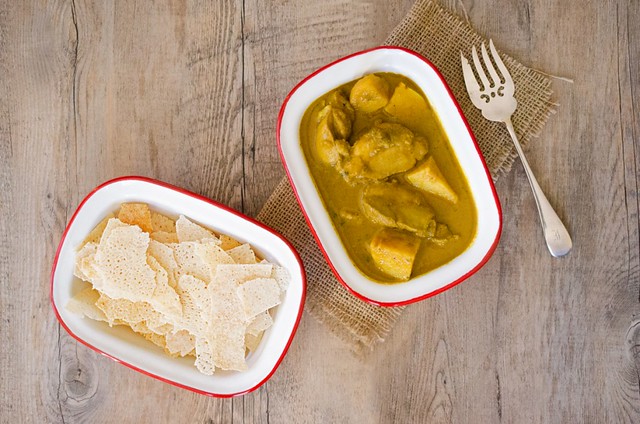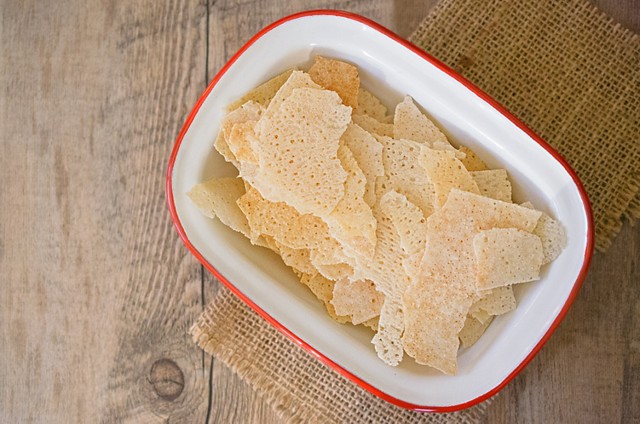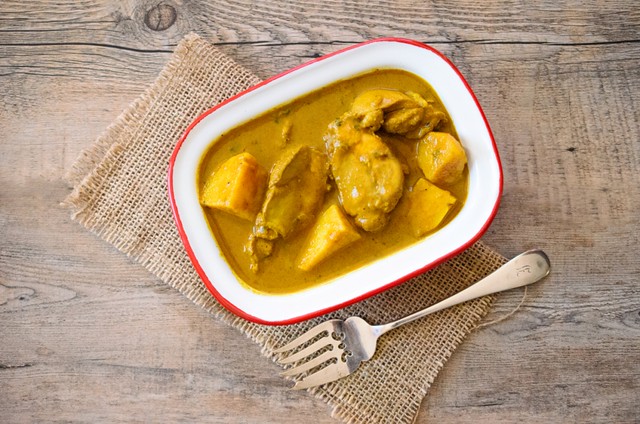If you ask any meat eating Mangalorean what their comfort food is, chances are this dish will be at the top of their list. 'Kori Rotti', also known as 'Kori Ghashi' is a traditional Mangalorean chicken dish that is loved all through the Konkan coast, and a staple in every household. 'Kori' is the Tulu word for chicken and rottis are a confusing addendum, because they have nothing to do with what people would normally think of as rotis. These 'rottis' are made of ground rice paste that is thinly spread and either dried or baked into crisp sheets. These sheets are then broken into pieces, and served with steaming hot chicken curry. The sauce softens the crisp rottis which are then messily devoured.
The origin of kori rotti has been lost to culinary history, with some claiming that it was a corruption of the spicier Kundapur chicken. Others claim that it originated in a hotel in the town of Udupi. It is usually associated with the 'Bunt' community in Mangalore, with their recipes being the most sought after.
Whatever the history of this dish, the essence of it is truly very coastal and South Indian with its light, flavourful notes of coconut, fresh cilantro and fragrant spices. Unusually for South Indian cuisine, its also very mild, and relies on its myriad spices for its delicate flavour and aroma. Its a staple at celebrations, and is truly a taste and texture sensation.
Unfortunately, the traditional accompaniment to this dish, the dry rice wafers or rotti is not very easy to find here in Canada. I usually source mine from Mangalore, and its the number one item that I beg anyone coming here to bring to me. This batch of rottis were brought to me by my cousin Crystal. Thank goodness for the great Indian trade network, eh?
The good news is that this curry can be eaten with pretty much any other accompaniment as well. I love having it as a Sunday lunch with soft sannas that soak up the light sauce, or just with some sweet, nutty pulao rice. I've even been known to gobble this curry up with pita bread or just plain white bread, its that addictive.
You can easily double or treble the spice mix, and store it in a dark place for future use. The onion mixture can also be made in larger quantities and frozen in ziplock bags, which makes it really easy to whip up this curry in a hurry. And like most Indian curries, it tastes fabulous the next day, and so you can also make this curry is large quantities and freeze in meal sized portions. Either way its a perfect introduction to the stunning cuisine of Mangalore.
Recipe:
(Printable Recipe)
1½ kilos chicken (I use thighs)
1 teaspoon turmeric
1 teaspoon (or to taste) sea salt
Spice Mix:
1½ tablespoons whole coriander seeds
¾ tablespoon whole cumin seeds
1 inch piece of cassia bark or cinnamon
5 whole cloves
5 green cardamom pods
1 star anise
2 whole mild red chillies (ideally Kashmiri)
¼ teaspoon whole peppercorns
¼ teaspoon whole peppercorns
1 teaspoon mild chilli powder (if hot, reduce to ¼ teaspoon)
The Onion Mixture:
1 teaspoon unscented oil
1 large onion, chopped roughly
1 inch piece of ginger, chopped roughly
5 fat cloves of garlic, chopped roughly
The Rest of The Dish:
2 tablespoons unscented oil or ghee
1 medium onion, diced fine
1 teaspoon tamarind paste
800 ml coconut milk (2 cans)
1 cup (250 ml) hot chicken stock
Hot water, if required
Salt to taste
Method:
Trim the chicken thighs of any fat, then toss the pieces with the turmeric and salt. Refrigerate for at least 2 - 3 hours.
Make
the spice mix. Toss each of the spices (except the chilli powder)
separately in a hot pan for between 30 seconds - 1 minute, then transfer
to a bowl. Let cool completely. Grind to a fine powder in a spice
grinder. Stir in the chilli powder. Keep aside.
For
the onion mixture, heat the oil in a small pan and add the chopped
onion. Fry, stirring for about 5 minutes, until the raw smell disappears
and the onion begins to soften. Add the chopped ginger and garlic and
fry for an additional minute. Let cool. Transfer to a blender and blend
to a fine paste. Keep aside.
When
ready to make the curry, heat the 2 tablespoons oil or ghee in a pot.
Add the diced onion and fry for 5 - 7 minutes, until the onion is just
beginning to colour.
Add the turmeric marinated chicken pieces, and fry on a high heat, stirring, until the chicken is sealed, about 5 minutes.
Add the spice mix and the onion paste to this mixture, stirring to make sure the chicken is coated.
Cook
for about 5 - 7 minutes, then add the tamarind paste, coconut milk and
stock. Cover and simmer on a medium-low heat until the chicken is cooked
through, usually between 15 - 30 minutes, depending on the size of your
chicken pieces. Taste and adjust the seasoning, adding a little salt/
extra tamarind paste if the curry needs it.
Keep
an eye on the curry and top up with a splash of hot water if the
mixture is getting too thick, as you want a thinner sauce for this
dish.
When the chicken is cooked, take off the heat. Taste and reseason, if required.














making this right now!!! will let you know how it goes!!!
ReplyDeleteHi Michelle,
ReplyDeleteThank you for sharing the Coconut Chicken Curry recipe,it looks like a very distinctive dish and we look forward to experimenting with it. We cater at many Indian weddings throughout the year and south indian dishes are increasingly in demand
Thank you. It certainly is very distinctive and much milder than usual curries.
DeleteHey Michelle.. Soo nostalgic right now.. did my engineering in Nitte which is the heart of the bunt community and we used to have it in our canteen all the time.. I WANT SOME NOW...!!! your pictures are amazing as well.. can almost feel the taste in my mouth.. Ok.. enough of the drooling.. hope all is well.. and maybe catch up in the UK sometime..
ReplyDeleteHaha, Andrea, I know what you mean, my grandma lives in Karkal close to Nitte... thanks for the compliments. Its so easy to make and you should certainly try it. Hopefully I will visit the UK again soon... things are so busy now that child is going to school full time. I hope you're doing fine and the family is all good :)
DeleteOhhh this sounds delicious!! I definitely have not attempted enough curries at home. Whenever a craving strikes I usually hit up my favorite take out place. Going to pin this so that I can give it a try and stick to home cooking more often!
ReplyDeleteThanks so much Stephanie. Its certainly easier than most curries, and here's a litle secret. Use pre-ground spices like cumin and coriander for your spice mix if you're short of time :) I love making my own mixes, but I do understand that it can be time consuming, which is why in this recipe I've actually split the processes to speed it up a bit.
DeleteMy mouth is watering.. please parcel it to Victoria...:)
ReplyDeleteLOL, hon, you need to come back soon :) And when you're there, invest in a spice grinder from Sears :)
DeleteI am so relieved it does not call for actual grated coconut! I still cannot figure out where or how to find that where I am! But this looks fabulous and is being pinned now!
ReplyDeleteLaura, the traditional recipe does call for grated coconut. But you do need a super powerful blender to get coconut down to the fine paste called for in this recipe. To be honest, I've been making it with coconut milk for years and the taste is identical, if a little better, cause even with my Indian mixer/ grinder, I've never got coconut ground down so smoothly. I also like to make traditional curries with ingredients I can get in my own city, which means improvising a bit :)
DeleteThis is making me seriously hungry. It sounds like a fantastic mix of flavours - just my sort of dish. The rottis look fascinating - I've never come across these. They must add an extra texture to the dish. I'm definitely on the lookout for some.
ReplyDeleteHi Michelle...tried this recipe today & its come out wonderful. Mark loved it because it wasn't quite spicy either. I used exactly the same measurements as per your recipe including the coconut milk. Superb. Thanks for the recipe. It wasn't time consuming neither was it hard. I learnt it in one preparation. Thanks again.
ReplyDeleteBeing from a Bunt family this dish is very close to my heart , and one of my favorite too ,None of our events can go by without this item on the menu, great post with amazing photos.
ReplyDeleteDoes anyone know where to find this in the US? If yes, please share.
ReplyDeleteDoes anyone know where to find the roti online in the US? If you do, please share.
ReplyDelete